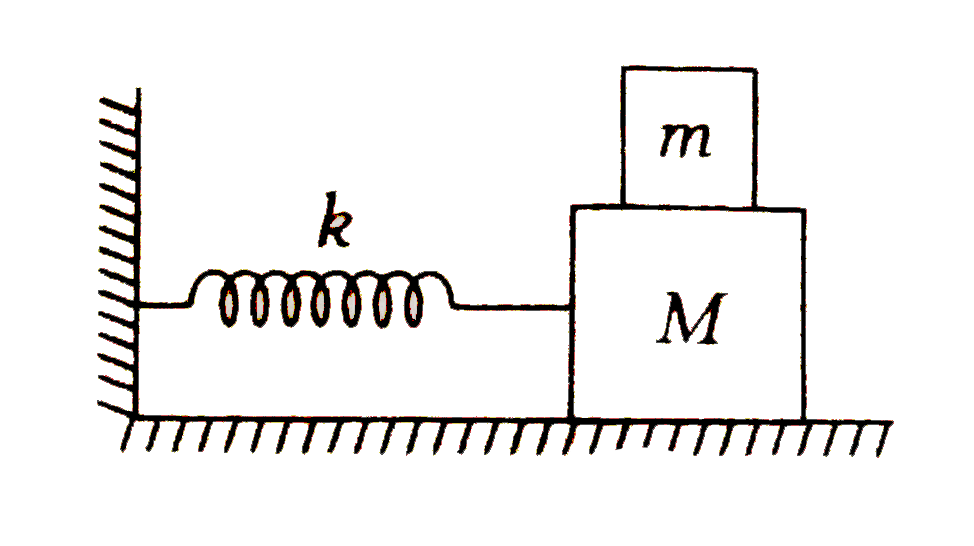Molten-wax of mass m drops on a block of mass, M which is oscillating on a frictionless table. Select the incorrect option.
amplitude does not change
amplitude increase
time period decrease
time period increases
The correct Answer is:D
To solve the problem, we need to analyze the effects of the molten wax of mass m dropping onto a block of mass M that is oscillating on a frictionless table. We will evaluate the options given in the question to identify the incorrect statement.
1. Understanding the System:
- We have a block of mass M oscillating on a frictionless table.
- A molten wax of mass m is dropped onto this block.
2. Effect on Mass:
- When the molten wax drops onto the block, the total mass of the system becomes M+m.
3. Time Period of the Oscillating System:
- The time period T of a mass-spring system is given by the formula:
T=2π√Mk
- Here, k is the spring constant.
- Since the mass of the system increases from M to M+m, the new time period T′ will be:
T′=2π√M+mk
- Since M+m>M, it follows that T′>T. Therefore, the time period increases.
4. Effect on Amplitude:
- The amplitude of oscillation is determined by the initial conditions of the system and does not change simply because additional mass is added. Thus, the amplitude remains constant.
5. Evaluating the Options:
- Option 1: Amplitude does not change. (This is correct)
- Option 2: Amplitude increases. (This is incorrect)
- Option 3: Time period decreases. (This is incorrect)
- Option 4: Time period increases. (This is correct)
Conclusion:
The incorrect options are:
- Amplitude increases (Option 2)
- Time period decreases (Option 3)
Thus, the answer to the question is that the incorrect options are Option 2 and Option 3.
- We have a block of mass M oscillating on a frictionless table.
- A molten wax of mass m is dropped onto this block.
- When the molten wax drops onto the block, the total mass of the system becomes M+m.
- The time period T of a mass-spring system is given by the formula:
T=2π√Mk
- Here, k is the spring constant.
- Since the mass of the system increases from M to M+m, the new time period T′ will be:
T′=2π√M+mk
- Since M+m>M, it follows that T′>T. Therefore, the time period increases.
- The amplitude of oscillation is determined by the initial conditions of the system and does not change simply because additional mass is added. Thus, the amplitude remains constant.
- Option 1: Amplitude does not change. (This is correct)
- Option 2: Amplitude increases. (This is incorrect)
- Option 3: Time period decreases. (This is incorrect)
- Option 4: Time period increases. (This is correct)
The incorrect options are:
- Amplitude increases (Option 2)
- Time period decreases (Option 3)
Similar Questions
A wedge of mass M lies on a smooth fixed wedge of inclination θ. A particle of mass m lies on the wedge of mass M in the figure. All surfaces are frictionless and the distance of the block from the fixed wedge is l. Find.

(a) Normal reaction between m and M
(b) the time after which the particle will hit the fixed plane.
View SolutionA block of mass M placed on a frictionless horizontal table is pulled by another block of mass m hanging vertically by a massless string passing over a frictionless pulley. The tension in the string is :
View Solution
Knowledge Check
Two blocks each of mass M are resting on a frictionless inclined plane as shown in fig then:
 AThe block A moves down the planeBThe block B moves down the plane.CBoth the blocks remain at restDBoth the blocks move down the plane.
AThe block A moves down the planeBThe block B moves down the plane.CBoth the blocks remain at restDBoth the blocks move down the plane.
Two blocks of masses m and m' are connected by a light spring on a horizontal frictionless table . The spring is compressed and then released . Find the ratio of acceleration of masses .
View SolutionThree blocks of masses m1,m2and m3 are connected by massless strings as shown on a frictionless table. They are pulled with a force T3=40N. If m1=10kg,m2=6kg and m3=4kg the tension T2 will be

View SolutionThree blocks of masses m1,m2andm3 are connected by mass less string as shown kept on a frictionless table.

They are pulled with a force T3=40N. If m1=10kg,m2=6kgandm3=4kg, the tension T2 will be
View SolutionA block of mass 'm' is connected to another block of mass 'M' by a spring (massless) of spring constant 'k' The blocks are kept on a smooth horizontal plane. Initially the blocks are at rest and the spring is unstretched Then a constant force 'F' starts acting on the block of mass 'M' to pull it. Find the force on the block of mass 'm' :
View SolutionTwo blocks of mass M and m are kept on the trolley whose all surfaces are smooth select the correct statement

View SolutionA mass M is attached to a horizontal spring of force constant k fixed one side to a rigid support as shown in figure. The mass oscillates on a frictionless surface with time period T and amplitude A. When the mass M is in equilibrium position, another mass m is gently placed on it. When will be the new amplitude of ocillation?


View SolutionA block of mass m1 rests on a horizontal table. A string tied to the block is passed on a frictionless pulley fixed at the end of the table and to the other end of string is hung another block of mass m2. The acceleration of the system is
View Solution
